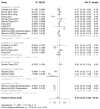Smartphone-Delivered Attentional Bias Modification Training for Mental Health: Systematic Review and Meta-Analysis
- PMID: 39222349
- PMCID: PMC11406109
- DOI: 10.2196/56326
Smartphone-Delivered Attentional Bias Modification Training for Mental Health: Systematic Review and Meta-Analysis
Abstract
Background: Smartphone-delivered attentional bias modification training (ABMT) intervention has gained popularity as a remote solution for alleviating symptoms of mental health problems. However, the existing literature presents mixed results indicating both significant and insignificant effects of smartphone-delivered interventions.
Objective: This systematic review and meta-analysis aims to assess the impact of smartphone-delivered ABMT on attentional bias and symptoms of mental health problems. Specifically, we examined different design approaches and methods of administration, focusing on common mental health issues, such as anxiety and depression, and design elements, including gamification and stimulus types.
Methods: Our search spanned from 2014 to 2023 and encompassed 4 major databases: MEDLINE, PsycINFO, PubMed, and Scopus. Study selection, data extraction, and critical appraisal were performed independently by 3 authors using the PRISMA (Preferred Reporting Items for Systematic Reviews and Meta-Analyses) guidelines. When necessary, we pooled the standardized mean difference with a 95% CI. In addition, we conducted sensitivity, subgroup, and meta-regression analyses to explore moderator variables of active and placebo ABMT interventions on reducing symptoms of mental health problems and attentional bias.
Results: Our review included 12 papers, involving a total of 24,503 participants, and we were able to conduct a meta-analysis on 20 different study samples from 11 papers. Active ABMT exhibited an effect size (Hedges g) of -0.18 (P=.03) in reducing symptoms of mental health problems, while the overall effect remained significant. Similarly, placebo ABMT showed an effect size of -0.38 (P=.008) in reducing symptoms of mental health problems. In addition, active ABMT (Hedges g -0.17; P=.004) had significant effects on reducing attentional bias, while placebo ABMT did not significantly alter attentional bias (Hedges g -0.04; P=.66).
Conclusions: Our understanding of smartphone-delivered ABMT's potential highlights the value of both active and placebo interventions in mental health care. The insights from the moderator analysis also showed that tailoring smartphone-delivered ABMT interventions to specific threat stimuli and considering exposure duration are crucial for optimizing their efficacy. This research underscores the need for personalized approaches in ABMT to effectively reduce attentional bias and symptoms of mental health problems.
Trial registration: PROSPERO CRD42023460749; https://www.crd.york.ac.uk/prospero/display_record.php?RecordID=460749.
Keywords: anxiety; attentional bias; depression; mental health problem; meta-analysis; mobile phone; smartphone; systematic review.
©Bilikis Banire, Matt Orr, Hailey Burns, Youna McGowan, Rita Orji, Sandra Meier. Originally published in JMIR Mental Health (https://mental.jmir.org), 02.09.2024.
Conflict of interest statement
Conflicts of Interest: None declared.
Figures







References
-
- Myruski S, Cho H, Bikson M, Dennis-Tiwary TA. Transcranial direct current stimulation (tDCS) augments the effects of gamified, mobile attention bias modification. Front Neuroergon. 2021 May 19;2:652162. doi: 10.3389/fnrgo.2021.652162. https://europepmc.org/abstract/MED/38235222 - DOI - PMC - PubMed
-
- Firth J, Torous J, Carney R, Newby J, Cosco TD, Christensen H, Sarris J. Digital technologies in the treatment of anxiety: recent innovations and future directions. Curr Psychiatry Rep. 2018 May 19;20(6):44. doi: 10.1007/s11920-018-0910-2. https://europepmc.org/abstract/MED/29779065 10.1007/s11920-018-0910-2 - DOI - PMC - PubMed
-
- GBD 2019 Mental Disorders Collaborators Global, regional, and national burden of 12 mental disorders in 204 countries and territories, 1990-2019: a systematic analysis for the Global Burden of Disease Study 2019. Lancet Psychiatry. 2022 Feb;9(2):137–50. doi: 10.1016/S2215-0366(21)00395-3. https://linkinghub.elsevier.com/retrieve/pii/S2215-0366(21)00395-3 S2215-0366(21)00395-3 - DOI - PMC - PubMed
-
- Di Carlo F, Sociali A, Picutti E, Pettorruso M, Vellante F, Verrastro V, Martinotti G, di Giannantonio M. Telepsychiatry and other cutting-edge technologies in COVID-19 pandemic: bridging the distance in mental health assistance. Int J Clin Pract. 2021 Jan;75(1):10. doi: 10.1111/ijcp.13716. https://europepmc.org/abstract/MED/32946641 - DOI - PMC - PubMed
Publication types
MeSH terms
LinkOut - more resources
Full Text Sources

